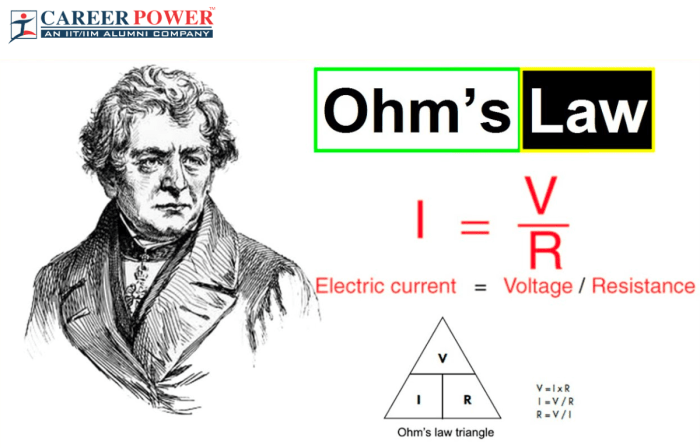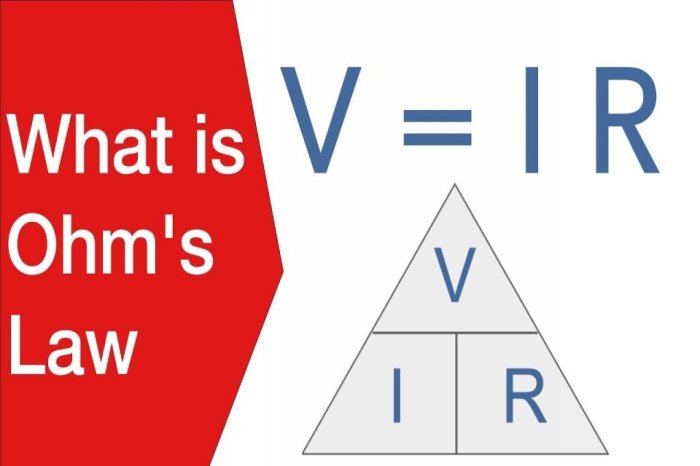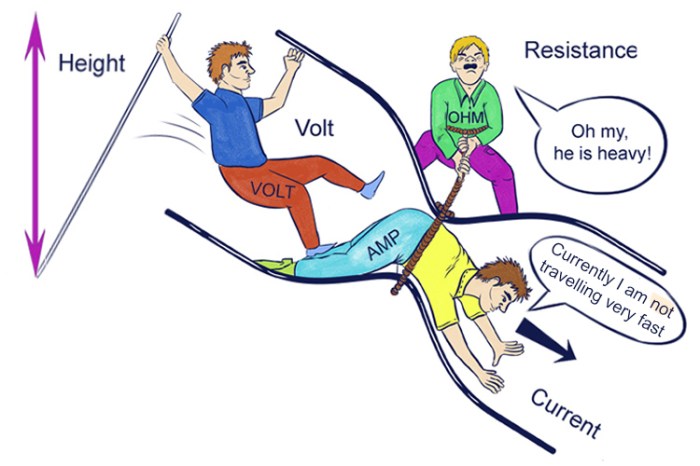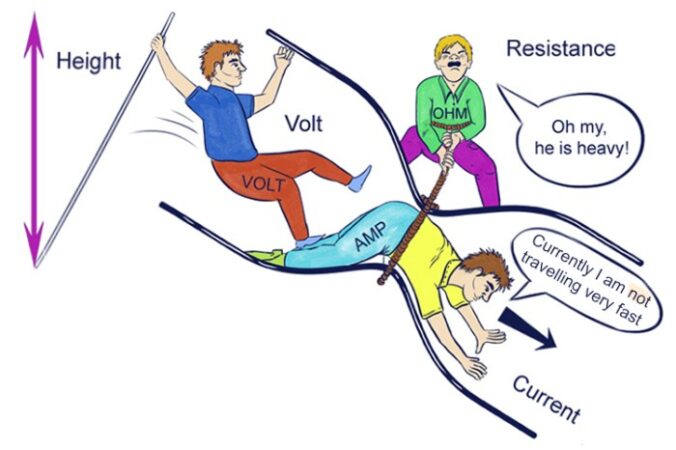
What are the ohm’s law – What are Ohm’s Law and its applications? This fundamental law, discovered by Georg Simon Ohm in the 19th century, governs the relationship between voltage, current, and resistance in electrical circuits. It’s a cornerstone of electrical engineering, providing a framework for understanding and predicting how electricity flows through various components.
Imagine a river flowing through a landscape. The voltage is like the water pressure pushing the river forward, the current is the amount of water flowing per second, and the resistance is the obstacles like rocks and bends that impede the flow. Ohm’s Law explains how these factors interact, allowing us to analyze and design circuits for various purposes.
Introduction to Ohm’s Law
Ohm’s Law is a fundamental principle in electrical circuits that establishes a relationship between voltage, current, and resistance. It is a cornerstone of electrical engineering and plays a crucial role in understanding and analyzing electrical circuits.
Ohm’s Law states that the current flowing through a conductor is directly proportional to the voltage applied across its ends and inversely proportional to the resistance of the conductor. This relationship is expressed by the following equation:
I = V/R
Where:
* I is the current flowing through the conductor (measured in Amperes)
* V is the voltage applied across the conductor (measured in Volts)
* R is the resistance of the conductor (measured in Ohms)
Historical Overview of Ohm’s Law
The discovery and development of Ohm’s Law can be traced back to the early 19th century. Georg Simon Ohm, a German physicist, conducted extensive experiments on the flow of electricity through wires. He observed that the current flowing through a conductor was directly proportional to the voltage applied across its ends.
Ohm published his findings in 1827 in a paper titled “The Galvanic Circuit Investigated Mathematically”. His work laid the foundation for understanding the relationship between voltage, current, and resistance, and his findings are now known as Ohm’s Law.
Key Individuals who Contributed to the Understanding of Ohm’s Law
Several key individuals played significant roles in the understanding and development of Ohm’s Law:
- Georg Simon Ohm (1789-1854): A German physicist, Ohm conducted experiments on the flow of electricity through wires, leading to the discovery of the relationship between voltage, current, and resistance, which is now known as Ohm’s Law.
- Alessandro Volta (1745-1827): An Italian physicist, Volta invented the first electric battery, which provided a reliable source of electricity for conducting experiments and further understanding electrical phenomena.
- André-Marie Ampère (1775-1836): A French physicist and mathematician, Ampère made significant contributions to the understanding of electromagnetism, including defining the unit of electric current, the Ampere (A), named in his honor.
- James Prescott Joule (1818-1889): An English physicist, Joule conducted experiments on the relationship between heat and electricity, leading to the development of Joule’s Law, which describes the heat generated by electric current flowing through a conductor.
Components of Ohm’s Law: What Are The Ohm’s Law

Ohm’s Law establishes a fundamental relationship between three key electrical quantities: voltage, current, and resistance. These components work together to determine the flow of electricity in a circuit.
Understanding the Components
- Voltage (V): Voltage represents the electrical potential difference between two points in a circuit. It is the driving force that pushes electrons through a conductor. Voltage is measured in Volts (V). Think of voltage as the pressure that pushes water through a pipe. The higher the pressure, the more water flows. Similarly, the higher the voltage, the more current flows through a circuit.
- Current (I): Current is the rate of flow of electric charge through a conductor. It is measured in Amperes (A). Imagine current as the amount of water flowing through a pipe. The more water flows, the higher the current. The higher the voltage, the greater the current.
- Resistance (R): Resistance is the opposition to the flow of electric current. It is measured in Ohms (Ω). Think of resistance as the friction in a pipe that hinders the flow of water. The higher the friction, the less water flows. Similarly, the higher the resistance, the less current flows through a circuit.
Relationship Between Components
The relationship between voltage, current, and resistance can be visualized in a table:
| Component | Symbol | Unit | Description |
|---|---|---|---|
| Voltage | V | Volts (V) | Electrical potential difference |
| Current | I | Amperes (A) | Rate of flow of electric charge |
| Resistance | R | Ohms (Ω) | Opposition to current flow |
Mathematical Expression of Ohm’s Law
Ohm’s Law is a fundamental principle in electrical circuits that establishes a relationship between voltage, current, and resistance. It provides a mathematical expression to quantify these relationships.
The mathematical formula for Ohm’s Law is:
V = I * R
Where:
* V represents voltage, measured in volts (V).
* I represents current, measured in amperes (A).
* R represents resistance, measured in ohms (Ω).
Rearranging the Formula
The formula V = I * R can be rearranged to solve for any of the three variables.
* Solving for Voltage (V):
The formula is already in its simplest form to solve for voltage.
* Solving for Current (I):
To solve for current, divide both sides of the equation by resistance (R):
I = V / R
* Solving for Resistance (R):
To solve for resistance, divide both sides of the equation by current (I):
R = V / I
Real-World Applications
Ohm’s Law finds numerous applications in various electrical and electronic systems. Some real-world scenarios where Ohm’s Law is applied include:
* Calculating the current flowing through a light bulb: Given the voltage of the power supply and the resistance of the light bulb filament, Ohm’s Law can be used to calculate the current flowing through the filament.
* Designing an electrical circuit: Engineers use Ohm’s Law to determine the appropriate values of resistors and other components to achieve the desired current flow and voltage levels in a circuit.
* Troubleshooting electrical problems: By measuring the voltage and current in a circuit, technicians can use Ohm’s Law to identify faulty components or potential issues.
Applications of Ohm’s Law
Ohm’s Law, a fundamental principle in electrical engineering and physics, is widely applied in various fields to analyze, design, and troubleshoot electrical circuits. Its simplicity and effectiveness make it an indispensable tool for understanding the relationship between voltage, current, and resistance.
Circuit Analysis and Design
Ohm’s Law is crucial in circuit analysis and design. It allows engineers to calculate the voltage drop across a resistor, the current flowing through a circuit, or the resistance needed for a specific application. By applying Ohm’s Law, engineers can determine the appropriate components for a circuit, ensuring optimal performance and safety.
For instance, when designing a circuit for a specific device, engineers can use Ohm’s Law to determine the required resistance value to ensure the device operates within its specified voltage and current limits.
Troubleshooting Electrical Problems
Ohm’s Law plays a vital role in troubleshooting electrical problems. By measuring the voltage and current in a circuit, technicians can use Ohm’s Law to calculate the resistance and identify any faulty components. For example, if a circuit is experiencing a short circuit, the measured resistance will be significantly lower than expected, indicating a fault.
Power Consumption Calculation
Ohm’s Law can be used to calculate the power consumed by an electrical component. The power dissipated by a resistor is directly proportional to the square of the current flowing through it and the resistance. This understanding is crucial for designing efficient and safe electrical systems.
Power (P) = Voltage (V) * Current (I)
For instance, a light bulb with a resistance of 100 ohms and a current of 0.5 amps consumes a power of 25 watts (P = 0.5 * 0.5 * 100 = 25).
Examples and Illustrations

Let’s visualize how Ohm’s Law works in real-world scenarios. We’ll explore a simple circuit, a practical application of Ohm’s Law, and a real-world example of determining current flow.
A Simple Circuit Demonstrating Ohm’s Law
Consider a basic circuit consisting of a battery, a resistor, and connecting wires. The battery provides the voltage (V), the resistor opposes the flow of current (R), and the connecting wires allow the current (I) to flow.
Imagine a battery connected to a light bulb. The battery provides the voltage, the light bulb acts as the resistor, and the wires allow the current to flow.
Voltage Drop Across a Resistor
Ohm’s Law is used in circuits to calculate the voltage drop across a resistor. For instance, in a car’s electrical system, the headlights are resistors. The voltage drop across the headlights determines their brightness.
Imagine a car’s headlights with a resistance of 10 ohms connected to a 12-volt battery. Using Ohm’s Law (V = IR), we can calculate the voltage drop across the headlights as 120 volts (12 volts x 10 ohms).
Determining Current Flow Through a Wire
Ohm’s Law is also used to determine the current flowing through a wire. Consider a wire carrying electricity to a household appliance. The current flowing through the wire depends on the wire’s resistance and the applied voltage.
Imagine a wire with a resistance of 0.5 ohms connected to a 120-volt outlet. Using Ohm’s Law (I = V/R), we can calculate the current flowing through the wire as 240 amps (120 volts / 0.5 ohms).
Limitations of Ohm’s Law
While Ohm’s Law is a fundamental principle in electronics, it’s important to recognize its limitations. It accurately predicts circuit behavior only under specific conditions. When these conditions are not met, Ohm’s Law may not provide an accurate representation of the circuit’s behavior.
Non-Linear Resistors
Ohm’s Law is based on the assumption of a linear relationship between voltage and current, meaning that the resistance remains constant regardless of the applied voltage. However, not all materials exhibit this linear behavior. Some materials, known as non-linear resistors, have a resistance that changes with the applied voltage. This non-linear relationship makes it difficult to accurately predict the current flow using Ohm’s Law.
For example, a common type of non-linear resistor is a diode. Diodes allow current to flow easily in one direction but significantly restrict current flow in the opposite direction. The resistance of a diode varies significantly depending on the voltage applied across it, making it difficult to use Ohm’s Law to calculate the current flow.
Limitations in High-Frequency Applications
Ohm’s Law is typically applied to circuits operating at low frequencies. However, at high frequencies, the behavior of components can become more complex, and Ohm’s Law may not accurately predict the circuit behavior. This is because at high frequencies, factors like capacitance and inductance become more significant, influencing the current flow.
For instance, a simple resistor may exhibit capacitive behavior at high frequencies due to the inherent capacitance between its leads. This capacitance can affect the current flow, making Ohm’s Law less accurate.
Limitations in Complex Circuits
Ohm’s Law is a simple law that applies to basic circuits with a single resistor. However, in complex circuits with multiple components connected in series or parallel, Ohm’s Law alone may not be sufficient to accurately predict the behavior of the circuit.
In such cases, it’s necessary to consider the combined effects of all the components, including their individual resistances, capacitances, and inductances, to understand the circuit’s overall behavior.
Practical Implications

Understanding Ohm’s Law has far-reaching implications in our daily lives, impacting electrical safety, energy efficiency, and the design of everyday appliances. It helps us make informed decisions about electrical usage, ensuring safe and efficient operation of electrical systems.
Electrical Safety
Understanding Ohm’s Law is crucial for electrical safety. By understanding the relationship between voltage, current, and resistance, we can identify potential hazards and take appropriate precautions.
For example, a high voltage coupled with low resistance can lead to a high current, potentially causing overheating, fire, or electrical shock.
Knowing this, we can avoid situations that could lead to such dangers, such as overloading circuits or using damaged electrical appliances.
Energy Efficiency, What are the ohm’s law
Ohm’s Law is also fundamental to energy efficiency. By understanding the relationship between current and resistance, we can minimize energy waste.
For instance, a higher resistance in a device means more energy is lost as heat, reducing efficiency.
Applying this knowledge, we can choose appliances with lower resistance, optimize wiring to minimize resistance, and ensure proper insulation to prevent energy loss.
Design of Electrical Appliances and Systems
Ohm’s Law plays a vital role in designing safe and efficient electrical appliances and systems.
Engineers use Ohm’s Law to calculate the appropriate resistance, voltage, and current for different components, ensuring safe operation and optimal performance.
For example, circuit breakers are designed based on Ohm’s Law to protect circuits from overload, preventing potential fires or damage to appliances.
Troubleshooting Electrical Issues
Ohm’s Law is a powerful tool for troubleshooting common electrical issues. By measuring voltage, current, and resistance, we can identify the source of a problem.
For instance, if a light bulb is not working, measuring the voltage across the bulb can help determine if the issue is with the bulb itself or the wiring.
Similarly, measuring the resistance of a circuit can indicate if there is a break in the wire or a faulty component.
Ending Remarks
From powering our homes and devices to understanding the intricate workings of electronic circuits, Ohm’s Law plays a vital role in our modern world. By grasping its principles, we can harness the power of electricity safely and efficiently, contributing to technological advancements and improving our everyday lives.
Answers to Common Questions
What is the practical significance of Ohm’s Law?
Ohm’s Law is essential for understanding how electrical components interact in circuits. It allows us to calculate voltage, current, and resistance, enabling us to design and troubleshoot circuits effectively.
How does Ohm’s Law relate to power?
Ohm’s Law is closely related to power calculations. Power (P) is the rate at which energy is transferred and can be calculated using the formula P = V * I (Power equals Voltage multiplied by Current).
Can Ohm’s Law be applied to all circuits?
While Ohm’s Law is a fundamental principle, it has limitations. It doesn’t accurately predict behavior in all circuits, particularly those with non-linear resistors or high-frequency applications.





